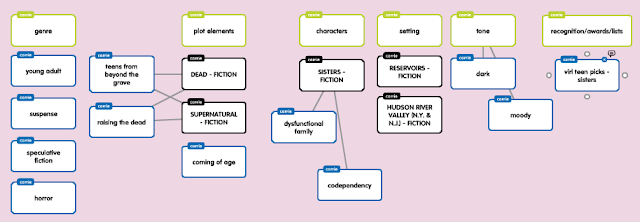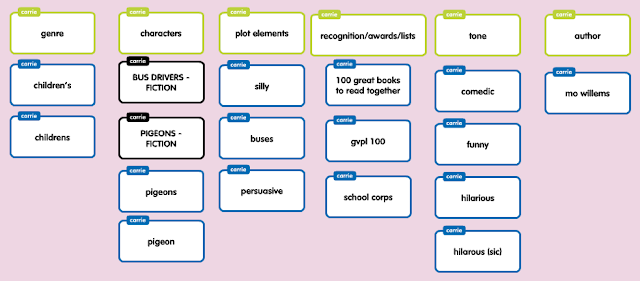I chose to look at social tagging vs. professional cataloging and classification. To help me explore the topic, I decided to examine the use of tagging at Seattle Public Library.
Social tagging
Tagging
would be considered a lightweight peer
production process, as contributors work independently on very simple tasks
with little involvement or interaction with other contributors (Haythornthwaite, 2009).
Leibenluft (2007), in talking about the success of Yahoo!
Answers, noted that "The questions—"Why does the stomach make funny noises when it's hungry?"
and "How do stoplights sense a car?" for instance—are
difficult to answer with a traditional Web search." The same could be said
of user tags. While LCSH subject headings cover objective aspects
of items, such as setting and characters, tags can give users a peek into
readers' subjective experiences with a text.
Tagging shares some similarities with social annotation. Gazan
(2008) notes that social annotators are
anonymous,
but have "perceived authority" due to the fact that
annotating indicates firsthand experience and an interest in taking the
time to add annotations. Annotations allow searchers access to multiple
perspectives on
items, and encourage further annotation (Gazan, 2008).
A key word that jumped out at me was "uncontrolled" as an essential characteristic of social annotations. Having tags that are not edited or removed is key to creating a system that is user-focused vs. expert-focused. Uncontrolled tagging also presents users in a positive light - each user is perceived as having valid and relevant ideas to contribute.
A key word that jumped out at me was "uncontrolled" as an essential characteristic of social annotations. Having tags that are not edited or removed is key to creating a system that is user-focused vs. expert-focused. Uncontrolled tagging also presents users in a positive light - each user is perceived as having valid and relevant ideas to contribute.
Tagging for 5 books
I started with a novel called "Imaginary
Girls" by Nova Ren Suma (2011). This is a
YA novel, so I thought it might be more likely to have tags, as many YA readers
are teens and likely more interested in tagging books.
These are the subject headings for "Imaginary Girls":
Subject
headings do a good job of representing factual elements of the item being
cataloged. These elements include setting (Hudson River Valley,
reservoir), characters (sisters), and
key plot elements (dead, supernatural). These are deliberately broad terms that
can be used to group items.
These are the tags for "Imaginary Girls":
Tags, on the other hand, tend to be
opinion-based and often more specific.
Interestingly, some of the tags represent sophisticated literary
elements such as tone - "moody" and "dark" give readers a
feel for how other readers reacted emotionally to the text. Tags such as
"codependency" and "dysfunctional family" add detail to the
subject heading "sisters."
To better understand the interactions
between subject headings and tags, I created a popplet. Categories created by
me are in green, subject headings are in black, and user tags are blue.
see it bigger here
I decided to expand
my search from YA fiction, and next looked up Haruki Murakami's
"1Q84" (2011). This book has a measly two tags -- "literature - japan" and "new
york times notable books 2011." Using the categories I created for
"Imaginary Girls," the tags indicate genre and
recognition/awards/lists. The lack of
tags is not due to low circulation or interest - at the time of this writing,
the library system's 39 copies were checked out, with 21 holds. The book had 9 comments. This shows that readers of
this book are willing to log on and comment on the book, but choose not to leave tags.
I
also looked up an all-time favorite of mine -- "All the Names" by Jose Saramago (2000)
-- that would fall into the same broad genre as "1Q84"
(literary fiction). The library has 4 copies, with 3 available and 1 hold. This book has no tags. Duguid (2006), when talking about peer
production systems Wikipedia and Gracenote, observed that "the far
reaches of the long tail truly suffer from neglect." This novel appears to be a good example of that.
For contrast, I decided to look at a
book that has been in the news recently -- "Fifty Shades of Gray" (2012).
This would qualify as a "hot topic" that Duguid (2006) said users need to be
aware of when using peer-produced resources. The library has 135 copies, with 355
holds. This is more than 4 times the number of 1Q84 copies. This made me wonder
whether books need to reach a "tipping point" to gather tags. If a book attracts enough eyeballs, is tag generation almost guaranteed?
These are the subject headings for "Fifty Shades":
These are the tags for "Fifty Shades":
"Fifty Shades" has 193 comments. From skimming the comments, a number of commenters found the book poorly written, but this is not reflected in the tags. Other commenter gripes not reflected in the tags is that the book is offensive because it portrays violence toward women, perverted/pornographic and inappropriate for library shelves, and overhyped.
This
made me wonder whether people choose to tag about the positive aspects of a
book, or at least ones that they think will be of use to others. For instance,
it may be helpful on an individual-item level to tag something as "poorly
written," but it is unlikely that people will run searches for poorly
written items.
To
round things out, I decided to examine the tags on a popular children's book,
"Don't Let the Pigeon Drive the Bus!" (2003). The library has 27
copies, with 4 available and 2 holds.
These are the subject tags for "Pigeon":
These are the tags for "Pigeon":
This book shows some of the possible problems
with tagging - repetition and misspellings or grammatical errors. Duplicate or
very similar tags include "children's" and "children's",
"pigeons" and "pigeon", and "hilarious" and
"hilarous" (sic). Such duplication and errors were not seen in the
other books, which made me wonder whether children were creating the tags. It's exciting to think about young library users being content creators within the catalog, but I wonder whether it would be useful to add spell-check or "Did you mean..."
into the tag creation system. Alternatively, the system could point out that a tag already exists and offer the option to "like" the tag as a form of participation.
How subject headings and tags can inform each other
These are the subject tags for "Pigeon":
These are the tags for "Pigeon":
see it bigger here
How subject headings and tags can inform each other
Subject
headings are carefully controlled, and tagging systems could benefit from some
quality control, as shown by the duplicates, misspellings, and grammatical
errors seen in the "Pigeon" tags. One tradeoff: it it may be
demotivating for taggers to see their duplicate tags removed from an item. One
possible way to deal with this is to have a "like" system for tags, to measure
how many people agree with a tag. This may encourage people to scan the tag
list before adding a duplicate tag and may boost participation - instead of
having to craft a tag, users can like tags that they agree with.
One way in which the practice of social tagging could inform the use of subject headings is by adding reader-level opinions and viewpoints. Subject headings are useful, but definitely aimed toward information professionals. I don't propose necesssarily mixing reader opinions in with subject headings, but it might help catalog users to see how tags align with or elaborate on subject headings. Libraries might consider encouraging users to "tag around" a subject heading. It seems that this behavior already occurs (unconsciously) to some extent, as "Imaginary Girls" showed that users added tags
(codependency, dysfunctional family) that provided some context for the
"sisters" subject heading. In the case of "Pigeon," tags
highlight a key aspect of the book -- humor -- that is not reflected in the
subject headings. Visualizations that bring together subject headings and user
tags could be the best of both worlds.
Conclusion
My examination of tags
for items at Seattle Public Library found that:
- it appears that some users choose not to tag, but are willing to leave comments. This points to the importance of having a variety of ways for users to generate content
- tags tend to reflect positive/useful aspects of the book. Comments are a better place to look for critical discussion.
- many tags can be linked to subject headings, and it may be fruitful for catalog users to be able to see connections between the two.
- High-circulating or popular items draw a sufficient number of tags, but other items suffer from tag neglect. I was reminded of Ling et al.'s (2005) examination of MovieLens users, and how highlighting users' uniqueness motivated participation. Perhaps libraries could e-mail users who have read books that have not been tagged, encouraging them to add a few tags to the item. To protect users' privacy, users would have to "opt in" to receive such e-mails.









Relating tags with formal subject headings is a great idea. You can imagine search results being broken down something like X hits in tags, Y hits in subject headings, Z hits in both and letting users explore from there.
ReplyDeleteRemember to post your final project topic! Appending your post or adding it as a comment is fine.
I really appreciate your detailed analysis of tagging vs subject headings. In your "Fifty Shades..." analysis, you mention that perhaps people only tag the positive aspects of material. Two things jumped out at me. First, maybe only people who like a thing tag it. This could explain why the social tags mostly seem positive. Second, maybe there's some moderation users don't get to see. Did you try entering a tag in the system? It would make sense that either tags must be approved before posted or moderators check for useful tags. By monitoring tags daily, the library can make the workload manageable. What are your thought on social tagging in general, and is it something you'd be looking forward to contributing to\using as a patron\student?
ReplyDeleteYou're onto something when you mention how far the extent of tags to go. People don't normally tag novels with negative descriptors, but if you're trying to describe a book as accurate as possible, perhaps some objectively negative tags would be appropriate. I say objectively because whereas some people might find a book offensive, others might find it otherwise. I find that "horror", "thriller", "romance" and etc don't really tell me THAT much about a novel. How many millions of novels are there that share those same tags? We can get really specific with tags here, but the question is, how descriptive can we get with tags before it starts to sound like a synopsis?
ReplyDelete